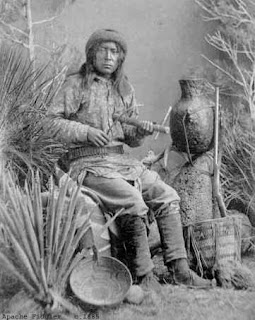American Indian music is the music that is used, created or performed by Native North Americans, specifically traditional tribal music. In addition to the traditional music of the Native American groups, there now exist pan-tribal and inter-tribal genres as well as distinct Indian subgenres of popular music including: rock, blues, hip hop, classical, film music and reggae, as well as unique popular styles like waila ("chicken scratch").
Music and history are tightly interwoven in Native American life. A tribe's history is constantly told and retold through music, which keeps alive an oral narrative of history. These historical narratives vary widely from tribe to tribe, and are an integral part of tribal identity. However, their historical authenticity cannot be verified; aside from supposition and some archaeological evidence, the earliest documentation of Native American music came with the arrival of European explorers. Musical instruments and pictographs depicting music and dance have been dated as far back as the 7th century.
Bruno Nettl refers to the style of the Great Basin area as the oldest style and common throughout the entire continent before Mesoamerica but continued only in the Great Basin and in the lullaby, gambling, and tale genres around the continent. A style featuring relaxed vocal technique and the rise may have originated in Mesoamerican Mexico and spread northward, particularly into the California-Yuman and Eastern music areas. According to Nettl, these styles also feature "relative" rhythmic simplicity in drumming and percussion, with isometric material and pentatonic scales in the singing, and motives created from shorter sections into longer ones.
refers to the style of the Great Basin area as the oldest style and common throughout the entire continent before Mesoamerica but continued only in the Great Basin and in the lullaby, gambling, and tale genres around the continent. A style featuring relaxed vocal technique and the rise may have originated in Mesoamerican Mexico and spread northward, particularly into the California-Yuman and Eastern music areas. According to Nettl, these styles also feature "relative" rhythmic simplicity in drumming and percussion, with isometric material and pentatonic scales in the singing, and motives created from shorter sections into longer ones.
 |
| Native American musician live performance |
While this process occurred, three Asian styles may have influenced North American music across the Bering Strait, all featuring pulsating vocal technique and possibly evident in recent Paleo-Siberian tribes such as Chuckchee, Yukaghir, Koryak. Also, these may have influenced the Plains-Pueblo, Athabascan, and Inuit-Northwest Coast areas. According to Nettl, the boundary between these southward and the above northward influences are the areas of greatest musical complexity: the Northwest Coast, Pueblo music, and Navajo music. Evidence of influences between the Northwest Coast and Mexico are indicated, for example, by bird-shaped whistles. The Plains-Pueblo area has influenced and continues to influence the surrounding cultures, with contemporary musicians of all tribes learning Plains-Pueblo influenced pantribal genres such as Peyote songs.
songs.
Vocalization and percussion are the most important aspects of traditional Native American music. Vocalization takes many forms, ranging from solo and choral song to responsorial, unison and multipart singing. Percussion, especially drums and rattles, are common accompaniment to keep the rhythm steady for the singers, who generally use their native language or non-lexical vocables (nonsense syllables). Traditional music usually begins with slow and steady beats that grow gradually faster and more emphatic, while various flourishes like drum and rattle tremolos , shouts and accented patterns add variety and signal changes in performance for singers and dancers.
, shouts and accented patterns add variety and signal changes in performance for singers and dancers.
Native American song texts include both public pieces and secret songs, said to be "ancient and unchanging", which are used only for sacred and ceremonial purposes. There are also public sacred songs, as well as ritual speeches that are sometimes perceived as musical because of their use of rhythm and melody. These ritual speeches often directly describe the events of a ceremony, and the reasons and ramifications of the night.
 |
| An Apache musician playing the Apache fiddle |
Vocables, or lexically meaningless syllables, are a common part of many kinds of Native American songs. They frequently mark the beginning and end of phrases, sections or songs themselves. Often songs make frequent use of vocables and other untranslatable elements. Songs that are translatable include historical songs, like the Navajo "Shi' naasha', which celebrates the end of Navajo internment in Fort Sumner, New Mexico in 1868. Tribal flag songs and national anthems are also a major part of the Native American musical corpus, and are a frequent starter to public ceremonies, especially powwows. Native American music also includes a range of courtship songs, dancing songs and popular American or Canadian tunes like "Amazing Grace , "Dixie", "Jambalaya" and "Sugar Time". Many songs celebrate harvest, planting season or other important times of year. [source: Native American Music]
, "Dixie", "Jambalaya" and "Sugar Time". Many songs celebrate harvest, planting season or other important times of year. [source: Native American Music]

No comments:
Post a Comment